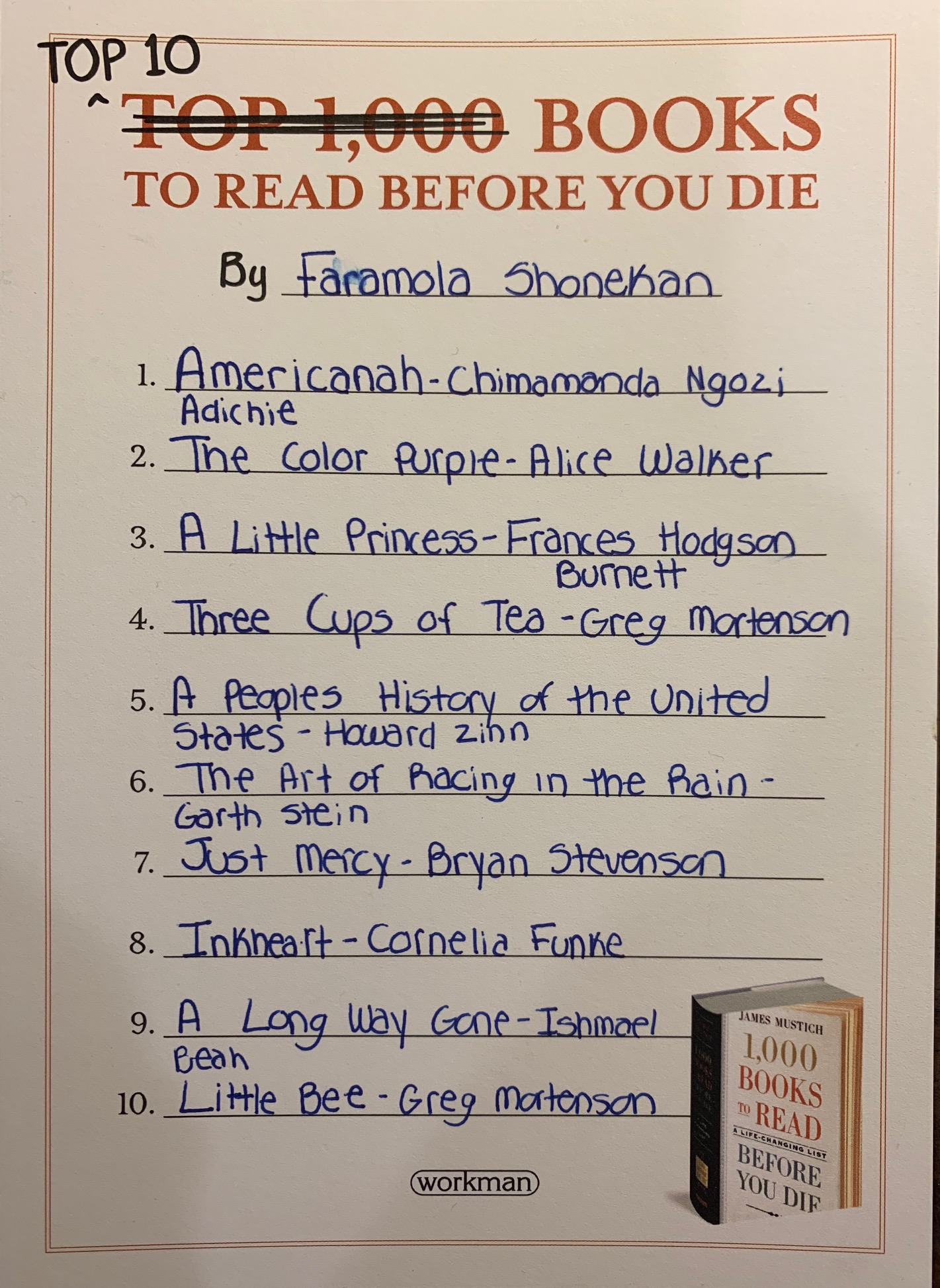Top 10 Books to Read before You Die

Looking for the top 10 books to read before you die? Check out these must-read classics: “1984” by George Orwell, “The Great Gatsby” by F. Scott Fitzgerald, “To Kill a Mockingbird” by Harper Lee, “Jane Eyre” by Charlotte Brontë, “Wuthering Heights” by Emily Brontë, “Pride and Prejudice” by Jane Austen, “Lord of the Flies” by William Golding, “Frankenstein” by Mary Shelley, “Moby Dick” by Herman Melville, and “The Handmaid’s Tale” by Margaret Atwood.
These timeless works of fiction will leave a lasting impact on readers. So, don’t miss out on experiencing these literary masterpieces.
1. 1984 By George Orwell
Dystopian Novel Exploring Themes Of Totalitarianism
One of the most influential works of literature ever written, George Orwell’s 1984 is a dystopian novel that takes readers into a future society where the government has complete control over every aspect of people’s lives. This masterpiece explores themes of totalitarianism, surveillance, and the loss of individuality, making it a thought-provoking and unsettling read.
The story revolves around Winston Smith, a low-ranking member of the ruling Party who begins to question the oppressive regime and seeks to rebel against it. As he navigates a world where Big Brother is always watching, Winston’s journey reflects the struggles faced by individuals in societies dominated by authoritarian regimes.
Orwell’s ability to create a haunting and bleak atmosphere is truly remarkable. Through vivid descriptions and a captivating narrative, he transports readers into a future that is both terrifyingly plausible and disturbingly familiar. The chilling portrayal of a society where truth is manipulated, privacy is non-existent, and dissent is ruthlessly suppressed forces us to question the power dynamics within our own societies.
1984 is a must-read for fans of political fiction and social commentary. Its relevance to our current world, where surveillance technology and government control are increasing, makes it an essential book to understand the dangers of totalitarianism and the importance of individual freedoms.
Take the opportunity to immerse yourself in Orwell’s dark and prophetic vision of the future by adding 1984 to your reading list. It is a mesmerizing novel that will leave you reeling long after you turn the final page.

Credit: www.skylarkbookshop.com
2. The Great Gatsby By F. Scott Fitzgerald
Classic American Novel Set In The Roaring Twenties
‘The Great Gatsby’ by F. Scott Fitzgerald is a classic American novel set in the Roaring Twenties. It immerses readers in the glamorous and decadent world of the Jazz Age, a time of excess and social upheaval. The novel follows the story of Jay Gatsby, a mysterious and enigmatic millionaire who throws lavish parties in the hopes of attracting the attention of his lost love, Daisy Buchanan.
Examines Themes Of Love, Wealth, And The American Dream
‘The Great Gatsby’ delves deep into the themes of love, wealth, and the American Dream. Fitzgerald’s masterful storytelling explores the characters’ pursuit of love and happiness in a world dominated by materialism and superficiality. Through the eyes of Nick Carraway, the narrator, readers witness the destructive power of wealth and the illusion of the American Dream. The novel serves as a cautionary tale about the hollowness of the pursuit of wealth and status.
Fitzgerald’s vivid and evocative descriptions bring the characters and settings to life, transporting readers to a bygone era of opulence and excess. The glitz and glamour of the parties contrast sharply with the characters’ inner turmoil and the disillusionment that lies beneath the surface. ‘The Great Gatsby’ explores the dark side of the American Dream, reminding readers that wealth and success do not necessarily guarantee happiness or fulfillment.
The novel’s exploration of love is equally compelling. The doomed love affair between Gatsby and Daisy epitomizes the complexity of human relationships and the lengths people will go to for the person they love. It exposes the destructive power of obsession and the consequences that arise when love becomes an unattainable ideal.
‘The Great Gatsby’ remains relevant today, long after its initial publication in 1925. Its examination of love, wealth, and the American Dream resonates with readers of all ages, reminding us of the universal human desire for happiness and fulfillment.
3. To Kill A Mockingbird By Harper Lee
Pulitzer Prize-winning Novel Addressing Racial Injustice In The 1930s South
“To Kill a Mockingbird” by Harper Lee is a Pulitzer Prize-winning novel that takes place in the 1930s South, where racial injustice was rampant. Through the eyes of Scout Finch, a young girl growing up in the fictional town of Maycomb, Alabama, readers are exposed to the harsh realities of racism and inequality.
Harper Lee skillfully captures the essence of the time period, delving deep into the racial tensions and prejudices that plagued society. The book shines a light on the unjust treatment of African Americans, exemplified in the trial of Tom Robinson, a black man accused of a crime he did not commit.
The novel not only addresses the systemic racism that prevailed in the 1930s, but it also explores themes of innocence, courage, and the complexities of human nature. Scout’s journey of self-discovery and moral growth serves as a powerful reminder of the importance of empathy and understanding.
A Powerful Coming-of-age Story With Enduring Lessons On Empathy
“To Kill a Mockingbird” is not only a story about racial injustice; it is also a powerful coming-of-age tale. Scout, along with her brother Jem and friend Dill, navigates the complexities of a divided society and discovers important lessons along the way.
Through their encounters with various characters in the novel, including their reclusive neighbor Boo Radley, Scout and Jem learn about the importance of walking in someone else’s shoes. This theme of empathy is woven throughout the narrative, teaching readers the value of understanding and compassion.
The lessons learned in “To Kill a Mockingbird” are timeless and continue to resonate with readers today. Harper Lee’s compelling storytelling and memorable characters make this novel an unforgettable read that is sure to leave a lasting impact.
In Conclusion
“To Kill a Mockingbird” by Harper Lee is a Pulitzer Prize-winning novel that tackles the issues of racial injustice in the 1930s South. Through the eyes of Scout Finch, readers are exposed to the harsh realities of racism and inequality. The novel also serves as a powerful coming-of-age story, with enduring lessons on empathy. Scout’s journey of self-discovery and moral growth teaches us about the importance of understanding and compassion. “To Kill a Mockingbird” remains a must-read for anyone seeking to broaden their perspective and gain insight into the complexities of the human condition.
4. Jane Eyre By Charlotte Bronte
Romantic Novel Featuring A Strong-willed And Independent Heroine
4. Jane Eyre by Charlotte Bronte
Jane Eyre by Charlotte Bronte is a timeless classic that every book lover should have on their must-read list. This romantic novel tells the captivating story of Jane Eyre, a courageous and determined young woman who overcomes adversity and fights for her independence.
In Jane Eyre, Bronte presents a strong-willed and independent protagonist who challenges the traditional gender roles of the Victorian era. Jane’s resilience and unwavering spirit make her a compelling character, inspiring readers to believe in the power of self-discovery and personal growth.
Explores Themes Of Love, Social Class, And Gender Roles
Throughout the novel, Jane Eyre explores a variety of thought-provoking themes such as love, social class, and gender roles. Bronte’s masterful storytelling delves into the complexities of these subjects, leaving readers with a deeper understanding of human relationships and societal ideals.
Love plays a significant role in Jane Eyre, as the story follows Jane’s journey in search of true and enduring love. From her strong yet tumultuous connection with Mr. Rochester to her unwavering devotion to herself, Bronte highlights the transformative power of love in all its forms.
Additionally, Bronte delves into the impact of social class on individuals’ lives, illuminating the disparities and injustices prevalent in Victorian society. Through Jane’s experiences as a governess in Thornfield Hall, Bronte exposes the harsh realities faced by those in lower social strata and challenges the norms and prejudices associated with class distinctions.
Moreover, Bronte’s exploration of gender roles subverts the traditional expectations placed upon women during the Victorian era. Jane Eyre defies societal expectations by asserting her independence, pursuing her passions, and forging her own path in a world dominated by men. By doing so, Bronte encourages readers to question and challenge existing gender norms.
Jane Eyre by Charlotte Bronte is a literary masterpiece that captivates readers with its compelling characters, intricate plot, and thought-provoking themes. Through the journey of its strong-willed and independent heroine, this novel reminds us of the importance of self-discovery, love, and the pursuit of personal freedom.
5. Wuthering Heights By Emily Bronte
Wuthering Heights by Emily Bronte is a Gothic novel that delves into themes of passion, revenge, and obsession. Considered a masterpiece of English literature, this novel continues to captivate readers with its haunting story and complex characters.
Gothic Novel Delving Into Themes Of Passion, Revenge, And Obsession
As a Gothic novel, Wuthering Heights immerses its readers in a world of dark and brooding atmospheres. It explores themes of passion, revenge, and obsession, which are at the heart of the story. The tumultuous love affair between Catherine Earnshaw and Heathcliff is filled with intense emotions that drive the narrative forward.
The novel expertly navigates the depths of these themes, presenting a tale that is both gripping and thought-provoking. Bronte’s exploration of love, societal expectations, and the consequences of one’s actions resonates with readers on a deep level.
In Wuthering Heights, Bronte creates a cast of complex and flawed characters, each driven by their desires and motivations. Heathcliff, the central figure of the novel, is a dark and enigmatic character consumed by his love for Catherine. His descent into obsession and ruthless pursuit of revenge adds a layer of suspense and tension to the narrative.
Catherine, on the other hand, is torn between her love for Heathcliff and the pressures of society. Her internal struggles highlight the conflicts between passion and societal expectations, ultimately leading to tragic outcomes.
Bronte’s writing style is evocative and atmospheric, painting vivid pictures of the Yorkshire moors and the titular Wuthering Heights estate. The harsh and rugged landscape serves as a reflection of the tumultuous emotions and relationships portrayed in the novel.
Wuthering Heights remains a timeless classic, captivating readers with its exploration of passion, revenge, and obsession. It serves as a reminder of the enduring power of love and the destructive nature of unchecked emotions.
6. Pride And Prejudice By Jane Austen
htmlBeloved novel focusing on societal expectations and the complexities of love
Features unforgettable characters and sharp social commentary
When it comes to classic literature, one cannot overlook Jane Austen’s timeless masterpiece, “Pride and Prejudice.” This beloved novel delves into the intricacies of societal expectations and the complexities of love in Austen’s signature style.
Set in 19th-century England, “Pride and Prejudice” introduces readers to a world where social status, wealth, and reputation dictate society’s rules. The story revolves around the Bennet family and their five daughters, particularly the headstrong Elizabeth Bennet. As the plot unfolds, we see how societal pressures and preconceived notions can influence personal judgements and relationships.
Austen’s expert portrayal of the characters makes them truly unforgettable. Elizabeth Bennet, with her wit, intelligence, and independent spirit, stands out as a timeless heroine. The enigmatic Mr. Darcy, with his initial arrogance and eventual transformation, remains one of literature’s most beloved romantic heroes.
What sets “Pride and Prejudice” apart is Austen’s sharp social commentary. Through the characters’ interactions and dialogues, she explores themes of class, reputation, and marriage. Austen’s critique of the societal norms and expectations of her time is as relevant today as it was when the novel was first published in 1813.
In conclusion, “Pride and Prejudice” is a must-read for any lover of classic literature. Its exploration of societal expectations, the complexities of love, and Austen’s keen social commentary make it a truly timeless piece of literature. So, grab a copy and immerse yourself in the world of the Bennet family and their journey towards self-discovery and true love.
7. The Catcher In The Rye By J.d. Salinger
Seminal Coming-of-age Novel Capturing Teenage Angst And Rebellion
J.D. Salinger’s The Catcher in the Rye is a seminal coming-of-age novel that has captured the hearts of readers for decades. The protagonist, Holden Caulfield, is a character that many can relate to, as he navigates the complexities of teenage angst and rebellion.
Salinger’s masterful storytelling allows readers to delve into Holden’s mind, experiencing his frustrations, insecurities, and moments of clarity. The novel explores themes of alienation, identity, and the search for meaning in a world that often feels inauthentic and disheartening.
The Catcher in the Rye has become an iconic piece of literature that continues to resonate with readers of all ages. Its raw honesty and compelling narrative have made it a must-read for those seeking a deeper understanding of the human experience.
8. Great Expectations By Charles Dickens
Great Expectations by Charles Dickens is a Dickensian classic that follows the life of an orphaned protagonist named Pip. This timeless novel explores themes of ambition, love, and societal inequality in Victorian England.
Dickensian classic following the life of an orphaned protagonist: In Great Expectations, Charles Dickens presents a captivating tale of a young boy named Pip who is raised by his abusive sister and her kind-hearted husband, Joe. With vivid descriptions and rich character development, the reader is immersed in the harsh realities of 19th-century England. Through Pip’s journey from a humble upbringing to unexpected prosperity, Dickens masterfully captures the struggles of the lower classes and the quest for social advancement.
Explores themes of ambition, love, and societal inequality: Great Expectations delves into various themes that are relevant even today. Pip’s longing for a better life, driven by his encounter with the eccentric Miss Havisham and her beautiful but cold-hearted ward, Estella, showcases the power of ambition and the pursuit of success. Yet, as Pip’s fortunes change, he is forced to confront the fickleness of love and the complexities of human relationships.
Furthermore, Charles Dickens paints a vivid portrait of societal inequality in Great Expectations. Through memorable characters like the cunning lawyer Jaggers and the enigmatic convict Magwitch, Dickens exposes the disparities between the rich and the poor, highlighting the injustices prevalent in Victorian society.
With its compelling narrative, Great Expectations has stood the test of time and continues to captivate readers of all ages. It is a must-read for anyone seeking a deep dive into the human condition and the triumphs and tribulations that shape our lives.
9. Moby Dick By Herman Melville
Epic Tale Of Obsession And Man’s Struggle Against Nature
Moby Dick by Herman Melville is an epic tale that takes readers on a thrilling journey through the depths of the ocean. This novel follows the story of Captain Ahab and his relentless quest for revenge against the famous white whale, Moby Dick. As readers delve into the pages of this masterpiece, they will find themselves captivated by the sheer force of Ahab’s obsession and the epic battle between man and nature that ensues.
Examines Themes Of Revenge, Fate, And The Human Condition
Moby Dick not only takes readers on a thrilling adventure but also explores profound themes that touch on the core of the human experience. Herman Melville delves deep into the human psyche, examining the complexities of revenge, the role of fate in our lives, and the depths of the human condition. Through captivating storytelling and lyrical prose, Melville invites readers to reflect on these universal themes and ponder the profound questions that arise.
As readers navigate the pages of Moby Dick, they will encounter unforgettable characters, such as the enigmatic Ishmael and the harpooner Queequeg, who each bring their unique perspectives and experiences to the narrative. Melville’s masterful portrayal of these characters adds depth and authenticity to the story, allowing readers to connect on a deeply human level.
Moby Dick is not a book to be read passively; it demands active engagement and contemplation. The rich symbolism, intricate allegories, and philosophical insights woven throughout the novel invite readers to delve into the depths of their own consciousness and grapple with the profound questions raised by Melville.
Whether you are a seasoned reader or new to the world of classic literature, Moby Dick is a must-read that will leave a lasting impression. It is a testament to the power of storytelling and the limitless depths of the human imagination. So, dive into the pages of this iconic novel and embark on a transformative literary journey like no other.
10. Frankenstein By Mary Shelley
Groundbreaking Science Fiction Novel Exploring The Consequences Of Playing God
Frankenstein by Mary Shelley is a groundbreaking science fiction novel that delves into the consequences of playing God. Published in 1818, this timeless classic has captivated readers with its thought-provoking narrative and themes. Shelley’s compelling story follows Victor Frankenstein, a young ambitious scientist who creates a living being through the power of science and alchemy. The novel raises fundamental questions about the limits of human knowledge and the ethical repercussions of tampering with nature.
Shelley’s writing style is immersive and vivid, allowing readers to experience the depths of Victor Frankenstein’s obsession and the horrors that unfold as a result. The unique blend of science fiction and gothic horror creates a captivating atmosphere that keeps readers engaged from beginning to end.
By pushing the boundaries of scientific possibilities, Shelley explores the complex relationship between creator and creation. As Victor Frankenstein grapples with the moral implications of his creation, readers are forced to question their own responsibilities in a world where scientific advancements continue to push the boundaries of what is possible.
Raises Philosophical Questions About Humanity And Responsibility
This seminal work of fiction goes beyond its science fiction elements and delves into deeper philosophical questions about humanity and responsibility. The creature created by Victor Frankenstein is abandoned and left to fend for himself in a harsh and unforgiving world. Through the creature’s perspective, Shelley challenges notions of our inherent goodness and our moral obligations towards others.
This thought-provoking narrative forces readers to reflect on the notions of empathy, compassion, and the human capacity for cruelty. The creature’s experiences shed light on the consequences of isolation and rejection, reminding readers of the ethical and societal implications of how we treat others.
Furthermore, Shelley’s exploration of the themes of power and ambition serves as a warning against the dangers of unchecked scientific progress and the potential loss of our humanity in the pursuit of knowledge.
In conclusion, Frankenstein by Mary Shelley is not just a captivating work of science fiction but also a powerful exploration of the consequences of playing God and the philosophical questions surrounding humanity and responsibility. Its timeless themes continue to resonate with readers, making this book a must-read for anyone seeking profound insights into the human condition.
Frequently Asked Questions On Top 10 Books To Read Before You Die
What Are 10 Must Read Books?
Some must-read books include “1984” by George Orwell, “The Great Gatsby” by F. Scott Fitzgerald, and “To Kill a Mockingbird” by Harper Lee. Other recommendations are “Jane Eyre” by Charlotte Brontë, “Wuthering Heights” by Emily Brontë, and “Pride and Prejudice” by Jane Austen.
“Lord of the Flies” by William Golding, “Frankenstein” by Mary Shelley, and “Moby Dick” by Herman Melville are also highly regarded.
What Are The Best Books To Read Before You Die?
Some of the best books to read before you die include “1984” by George Orwell, “The Great Gatsby” by F. Scott Fitzgerald, “To Kill a Mockingbird” by Harper Lee, “Jane Eyre” by Charlotte Bronte, and “Wuthering Heights” by Emily Bronte.
These books offer unique perspectives and unforgettable stories that every reader should experience.
What Is The #1 Most Read Book In The World?
The #1 most read book in the world is the Holy Bible.
What Is The 3 Most Read Book In The World?
The three most read books in the world are: 1. “The Holy Bible” 2. “The Holy Quran” 3. “The Harry Potter series” by J. K. Rowling.
Conclusion
In the world of literature, there are certain books that leave an indelible mark on us, books that we should all read at least once in our lifetime. These books have the power to transport us to different worlds, evoke deep emotions, and broaden our perspective.
From timeless classics like “1984” and “To Kill a Mockingbird” to captivating novels like “The Great Gatsby” and “Pride and Prejudice,” these are the books that will stay with you long after you turn the last page. So, grab a copy of these top 10 books and embark on a journey that will enrich your mind and soul.




